by Thomas Kurz
Most sports and m.a. instructors, suffering from mental inertia, apply to adults methods of increasing flexibility that were designed for children. These methods, proven to be quite effective for children, are much less effective for adults. One would expect an instructor to have read up on functional anatomy and exercise physiology prior to training others. Even a little study of joints would reveal that they change with age, that there are certain positions that make stretches completely ineffective, even harmful, and that there are other positions that make stretches more effective and healthy. Here are examples of just the changes that happen with age:
The angle between the shaft of the thigh bone and its neck (the part that ends with the head of the thigh, which fits into the hip socket) changes with age. At birth it is about 135 degrees, which lets little children abduct their thighs further than adults, in whom this angle usually is about 125 degrees.
A deep back bridge requires well retracted and depressed shoulder blades. That in turn requires a good extension of the thoracic spine, which usually bends forward and loses mobility as people age and spend a long time sitting, beginning in the school bench.
The significance of these changes is explained in chapter “Introduction” on Flexibility Express DVD (pay attention from 2:20 on). Below you can view the first five minutes of that chapter.
First five minutes of chapter “Introduction” from Flexibility Express DVD
Children’s muscles and ligaments are more pliable than those of adults, due to smaller muscle mass around joints and to age-related changes in the fibrous connective tissue.
One can learn all that by studying anatomy, or one can observe athletes of various sports, those that require beginning training at a very young age and those that do not.
A thinking person, analyzing everyday observations, would notice what works and what doesn’t and would not persist in making adults use those stretches that can’t work for them. A thinking person would notice that the gymnastic stretches and methods of flexibility training work best with those who begin their training before the age of 12 and work very poorly with those who begin past the age of 16, and the later the worse. Such persons would also notice that there is a sport in which all athletes display both great flexibility and great strength (that’s a hint), even though very many of them begin training long past the age of 16. The sport is so strenuous, and it puts such a great load on one’s joints (another hint), that if they were not in the safest positions they would be destroyed.
What sport is that? A fairly popular one. To know which one, you have to watch more than your own. There are many lessons in other sports that apply to your own, but you have to watch them. Yogi Berra said, “You can observe a lot by watching,” so it follows that if you don’t watch much, you can’t “observe” a lot.
Anyway, such watching and thinking (what Yogi Berra meant by “observing”), should lead one to apply the relevant exercises from that sport to athletes who are too old for kiddie stretches of gymnastics. How many instructors do that? So far, I have not seen evidence of any instructor (other than me) doing that. How many are able to follow the hint in this article and devise a flexibility program effective for both children and adults? Very few, if any, I am afraid. (Those were rhetorical questions.)
Now, a question (not a rhetorical one), but only to those who do not have the Flexibility Express yet: What is the sport I am hinting at, the one in which all athletes display both great flexibility and great strength?



Olympic weight lifting?
I’ll say FOOTBALL
Yoga?
Weight Lifting no doubt.
Martial Arts
Yoga! 🙂
Gymnastics
IT’S NO DOUBT OLYMPIC WEIGHTLIFTING THEY R THE MOST FLEXIBLE & STRONG ATHLETES IN THE WORLD!
It’s got to be gymnastics!
I know the answer because it is on the DVD: although I did read the research that summarised the flexibility of all sports from one Olympics.
The dvd and this article have proven useful in my work with young trampolinists too. The coaches are insistent on static stretching and “deselect” people who can’t perform them.
Powerlifting
i would also go with Olympic weight lifting.